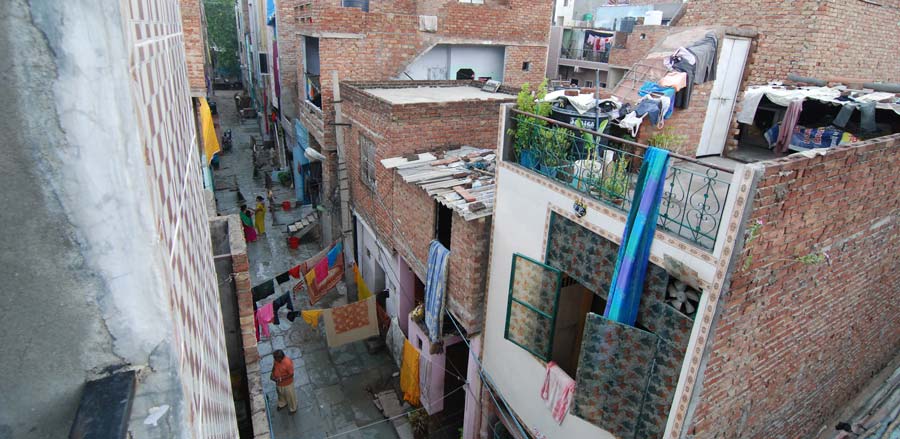Safe and Quality Housing at Your Digital Fingertips
Rakhi Mehra reveals the story behind a pioneering digital tool that wants to help revolutionise the quality of informal housing. After a few clicks, users receive a customised construction manual and cost-overview with the aim of ensuring that their house meets the safety requirements it needs to stand the test of time.
The informality in housing: In India, 126 million people live in informal housing, which consist of overcrowded and substandard structures that are non-engineered (built without any technical supervision).
The daily quake: 7 people die daily due to building collapses.
The skill divide: 97 per cent of the informal construction workforces in India do not have any formal training.
The earthquake: Over 60 per cent of structures in Nepal are unsafe. In 2014, 9,000 lives were lost in Nepal. Earthquakes don’t kill people, poor buildings do.

© Marco Ferrario
If you are reading this, you are either panicking at the large-scale disaster that is waiting to strike, or you are determined (like us) to find an innovative solution for the Sustainable Development Goal Number 11: Making human settlements and cities safe, resilient, and sustainable.
Some ideas might have already begun to cross your mind:
- If only regulators could enforce building codes and safety regulations, then these violations would not happen, and it would save lives.
- If only governments could provide subsidised or public housing, then people would not need to build their homes themselves.
- If only land titles would be formalised, then credit would flow and the quality of homes would improve.
- If only architects’ and engineers’ expertise were accessible, it would enable better quality of informal housing
A Life-Changing Visit to Mangolpuri
In 2009, the architect Marco Ferrario and his colleagues visited Mangolpuri, a neighbourhood housing over 70,000 in East Delhi.
Marco recalls: “In every lane we walked down, construction was rampant. There was cement mix and bricks piled up on the streets.” And this was not for a temporary structure, but for reinforced concrete (RCC) buildings, most of them multi-story. The local mason came from a trusted neighbourhood reference, the financing from savings and informal sources, and the designs from what was seen around.
However, oversights were visible and they were unlikely only the result of cost-savings. Often it was a matter of putting two more stirrups (a closed loop of a reinforcement bar) on the columns at a key juncture and leaving a gap in-between the neighbouring walls – simple, yet critical best-practice construction methods that reduce the risk in the event of a disaster. The architects began to see an opportunity to influence the quality of construction. Housing needs to be seen as a life-time investment that impacts our day-to-day quality of life.
As a result, Marco Ferrario and Rakhi Mehra, co-founders of mHS CITY LAB, decided to focus their interdisciplinary practice on the forgotten and often ignored issue of housing quality. With Rakhi’s background in micro-finance, mHS collaborated with the Indian Micro-Finance Institution (MFI) to design an innovative product for informal sector customers, offering home improvement loans with technical assistance.

© Marco Ferrario
Could a Digital Construction Tool Bridge the Gap?
With this ambitious vision, mHS CITY LAB created a prototype web-based tool – NEEV (the Hindi word for foundation) – packed with architectural and engineering data. The tool’s scope would be to assist users to make informed decisions related to budgeting and construction practices. The first experiment was aimed directly at households and their masons.
Shobha, 36, an MFI customer who applied for a loan, was scared that she would run out of money to complete her house. She then collaborated with mHS and shared her experience receiving the technical support in this video. It raised not only her own understanding and awareness, but also influenced the community to question existing practices.
Going Digital to Scale
For mHS and Marco, after the year-long pilot of providing door-to-door assistance to 30 households – the urgent question was how to create awareness, scale the concept, and make the tool widely accessible to the millions that self-construct every day.
Thus, mHS pivoted to work with intermediary agencies. Today, the target users are field officers working with habitat organisations and housing microfinance agencies. To use the tool, the field staff input simple project data related to the proposed construction – from flooring, toilets to a multi-storey building. The system automatically generates a detailed budget, monitoring tools for construction costs, and a customised construction manual. The process is designed to be interactive with the household, and user-generated data can also be shared via SMS or WhatsApp.
During a three-month trial, which was supported by CISCO’s CSR Critical Basic Needs Programme, two organisations deployed NEEV, thus facilitating techno-financing assistance to 300 households. mHS will release an updated version of NEEV 2.0 in early 2020, with intuitive mobile-app and offline functionality. This will be available for free for end-users and on a license agreement to partnering organisations.

© Marco Ferrario
A Journey Towards Safer Construction
These are still early days. The beginning of a digital transformation journey is not without its challenges. There was an initial period of on-boarding the users that were transitioning from paper-based data collection systems. There was also hesitation when it came to trusting the technical accuracy of the new digital system and a fear that the transparency would generate potential conflicts between the mason and the homeowner.
A core strategy has been to work with partnerships. Rakhi highlights: “We work with trusted community-based lending agencies MHT SEWA and SAATH in order to drive the change bottom-up”.
There is no second chance when it comes to debating the quality of housing. Along with the urgency to provide housing for all, we need to value inclusive, safe and resilient housing. Leveraging digital tools is one such opportunity to empower low-income users to get their foundation right.
- Safe and Quality Housing at Your Digital Fingertips - 28. January 2020
